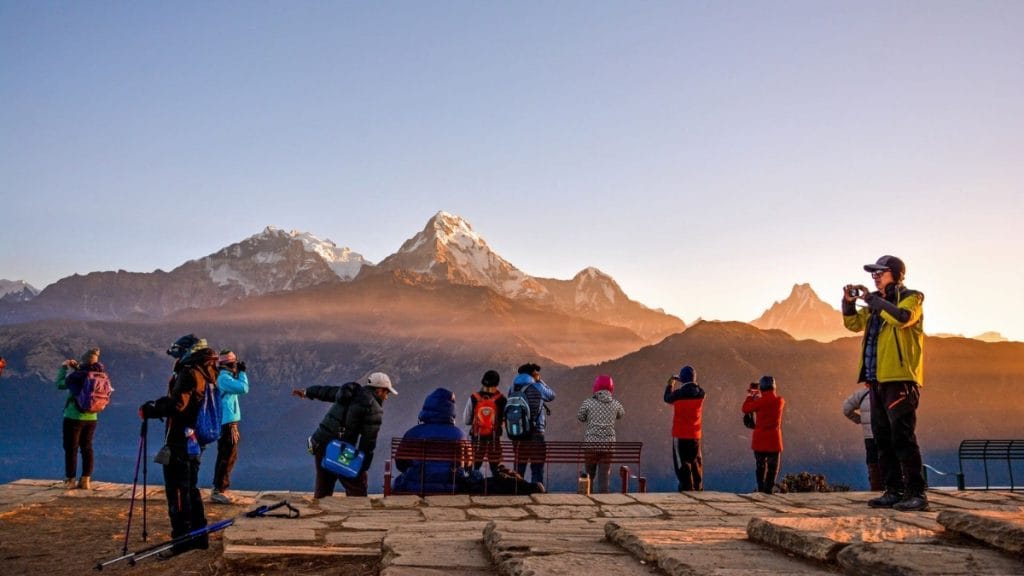Image: Google
In Nepal, the more tourists arrive, the more officials get paid. Yet the government does little to bring them in.
Every year, more than a million foreign visitors fly in to trek Himalayan trails or trace the Buddha’s footsteps. Their money pays porters and guides, fills tax coffers, and funds a chain of economic activity that stretches from Kathmandu’s boutique hotels to roadside noodle stalls in the highlands. Yet the very sector that helps balance the budget receives little strategic investment in return.
Tourism’s importance is intuitive, but its mechanics are now better understood thanks to one econometric study by Shoorabeer Paudyal, an economist at Tribhuvan University. His research, covering 35 years of data, used a technique to untangle the sector’s relationship with macroeconomic indicators. It found a curiously lopsided dependency: tourism spurs growth in output, exports, consumption and tax revenue. But few of these variables, public investment included, appear to spur tourism in return.
The effect is small in absolute terms but big relative to the size of the economy. Tourism accounts for roughly 7% of foreign exchange earnings and 25% of exports when services are included. It supports up to 100,000 direct jobs. The income multiplier—a measure of how much extra output is generated for every rupee earned from tourism—is estimated at 1.21. That is not so much: Sri Lanka’s is higher, and in Mexico it crosses 1.6. But for a country reliant on remittances and occasionally short of foreign reserves, the extra 21 paisa per rupee is a welcome lift.
Why then does Nepal’s tourism sector underperform relative to its potential? Part of the answer is down to leakages. Around 48% of the tourism rupee is estimated to exit the economy via imports. Hiking poles from China, sun cream from Europe, fuel from India: Nepal packages an international product and sells it domestically. The result is a weak domestic supply chain and shallow backward linkages. Tourists may sleep in Nepali beds, but they eat Thai noodles, fly on Middle Eastern carriers, and buy gear from Australian brands. A huge share of what looks like Nepali GDP, on closer inspection, belongs elsewhere.
Ownership matters, too. Foreign airlines and multinational hotel chains command the most profitable segments of the value chain. Of the some 20 international airlines flying into Kathmandu, only one is Nepali. The flagship carrier, Nepal Airlines, operates fewer than five wide-body aircraft and has struggled with corruption and mismanagement for years. Meanwhile international firms dominate bookings and tour packaging. The country’s role, increasingly, is that of a subcontractor: essential but dispensable.
Even the benefits that do accrue tend to be thinly spread. Employment in tourism is labour-intensive but tends to be informal. Wages are low; jobs seasonal. Each tourist creates roughly one job per 15 visits, a global average, but with few rights or protections. Government data from the Ninth Plan (1997–2002) estimated 182,000 tourism-related jobs, of which fewer than half were direct. Though the numbers have since leapt, the pattern persists. Porters in Langtang and Thamel waiters alike depend on foot traffic that is seasonal and highly sensitive to shocks.
Some patterns, however, are reassuringly stable. Tourism receipts exhibit a statistically significant two-way relationship with GDP, tax revenue and exports. Put more plainly: tourists not only respond to growth, they help cause it. In Dr Paudyal’s model, a surge in arrivals precedes increases in per capita income. One German trekker in Manang may do more for GDP than a mid-level bureaucrat in Singha Durbar.
Yet investment behaviour does not reflect this. Government spending on infrastructure (eg, roads airports) has followed tourist flows but not led them. A newly paved road to a trekking region tends to arrive after the tourists do. Investment, in other words, is reactive rather than catalytic. Despite public commitments, Nepal lacks a tourism satellite account to track the sector’s full contribution. Planning decisions proceed on partial data, and the sector’s fiscal importance is usually understated.
Contrast this with Bhutan, which has opted for a “high-value, low-volume” model. Its daily fee for tourists, recently reduced but still dearer, serves as both a revenue tool and a filter. Nepal has gone the other way, favouring volume over value. This brings more visitors but limits profitability. Average spending per tourist is around $48 a day, according to government figures, barely above subsistence for high-altitude tourism. The market is growing, the margins are not.
Remittances continue to dominate economic discourse. But tourism is, in theory, more productive. A migrant worker sends money home once a month. A tourist spends money locally every hour. Unlike hydroelectricity or agriculture, tourism requires relatively little gestation. It also generates taxes more directly: VAT, hotel levies, entry fees. In a cash-strapped state, this should count for something.
The risk is that even this could decline. Competition from regional rivals and the increasing effects of climate change on trekking routes all loom. Melting glaciers make for dramatic views but unstable trails. Domestic air safety remains patchy: some 20 airlines are banned from European airspace. Even loyal tour operators abroad admit that Nepal, for all its charm, is a harder sell than it once was.
Still, the sector offers one thing others in Nepal often do not: liquidity. Tourists spend immediately, in convertible currency, on goods and services that are taxed at the point of sale. If only the benefits stuck around. When the tourists leave, the money too takes flight—upwards into foreign accounts or downwards into consumption. Without deliberate reinvestment in domestic linkages such as Nepali-owned transport and logistics, the echo of tourism will stay fainter than the mountains suggest.
Nepal, famously, is where mountaineers come to ascend. The same cannot be said of the money they bring. ■

